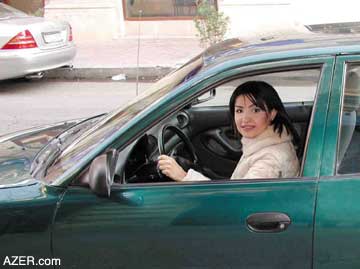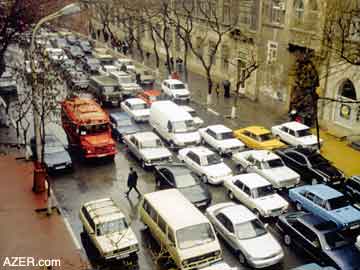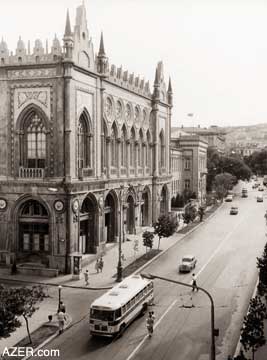|

Winter 2003 (11.4)
Pages
66-68
Women Drivers
"Hey
Dragon! Need a Driver?"
by Arzu Aghayeva
  We're seeing more and
more women drivers in Baku these days. During Soviet times, you
could count the number of them on the fingers of your one hand.
That was Baku. Forget about the other cities and towns of the
Azerbaijan Soviet Republic. We're seeing more and
more women drivers in Baku these days. During Soviet times, you
could count the number of them on the fingers of your one hand.
That was Baku. Forget about the other cities and towns of the
Azerbaijan Soviet Republic.
But the situation was different in some of the other parts of
the former Soviet Union. I remember back in 1980s when I was
about seven years old, my family traveled to Moscow and Tallinn
(Estonia), and I was so surprised to see so many women drivers
there.
I'm 23 now. I've been driving a few months here in Baku. In many
western countries, a young woman my age would already have been
driving six or seven years. But it was a big decision for me
to get behind the wheel. Believe me, it's been quite an experience.
In my opinion, the fact that Azerbaijani women hardly drove at
all during the Soviet times has mostly to do with economics and
traditional expectations in society where the head of the family
- the man - was expected to take on that responsibility. Since
cars somehow fall into the category of being technical, women
didn't even make an attempt to learn to drive. Of course, that
was a stereotypic response, as today young women handle many
technical jobs, such as computers.
Perhaps, they thought they would not be able to master driving
and everything that came with it. Soviet cars were unreliable:
they often broke down and drivers had to tinker with them a lot.
But these days women mostly drive foreign cars such as Hyundai,
Mercedes, BMW and Daewoo, which are much more reliable.
  Left: Women drivers are a relatively new phenomenon
in Baku. Arzu Aghayeva has been getting around town in a green
Hyundai since summer. Left: Women drivers are a relatively new phenomenon
in Baku. Arzu Aghayeva has been getting around town in a green
Hyundai since summer.
In Soviet Times
Back then, the official cars were either black or white. The
most typical model was a comfortable sedan called the Volga in
which officials were chauffeured around.
The smaller personal car was called Zhiguli. You could seat four
people comfortably. Both were manufactured in the Soviet Union.
Unlike the West where people trade in their cars every two or
three years, those cars were usually driven, repair after repair
after repair, until they virtually fell apart.
Besides, the truth is, not so many people owned cars. To get
one, you had to register and wait in a queue for two or three
years. It was similar to the way you got an apartment at that
time. It's rather amazing to see photographs of our streets only
a decade ago. They're really quite empty. There were hardly any
cars at all, compared to now.
Independent Women
One of the reasons why driving practices are changing is because
Azerbaijani women are becoming more independent. Many women work
and earn their own money and can afford a car. In fact, young
women often earn more money than their parents do. A 20- year
girl working in a foreign company may draw a much higher salary
than her 50-year-old father. Foreign cars are being imported.
Put your money down in cash and you can pick one up the same
day.
So women are starting to get behind the wheel these days. Even
when I was taking driving lessons, I noticed that 80 percent
of the students were women. My instructor confirmed that he teaches
mostly women these days, which is even more profitable for him
because guys mostly learn with their friends or dads in open
places, like countryside roads or en route to their country homes
["bagh" in Azeri, or "dacha" in Russian].
It's not the same with women. They seem to take driving more
seriously and prefer to take classes with a professional instructor,
receiving guidance in a specially designed vehicle with brake
and clutch pedals on the passenger's side where the instructor
sits.
It doesn't surprise me anymore when I see that there are women
drivers both behind and next to me at traffic lights. In fact,
it just encourages me more. It seems there's a kind of mutual
understanding between us. When I see an older woman behind the
wheel, I feel enveloped and somehow protected, something like:
"I've already been through the stages that you are passing
through." Women drivers usually exchange smiles with me
before continuing on their way.
Below: Drivers in Baku have
their own set of rules that may seem chaotic to the foreigner,
but seem to work fairly well in Azerbaijan.
  "Tom-and-Jerry Effect" "Tom-and-Jerry Effect"
But woman drivers are still rare enough to arouse a response
of surprise in society. I call it the "Tom-and-Jerry-Effect"
with reference to Walt Disney's cartoon series where Jerry, the
mouse, always attempts to trick Tom, the cat. At first, Tom just
looks rather nonchalantly at the object that Jerry has created
to heckle him.
He continues what he was doing until suddenly it dawns upon him
that he's in real danger - like a bomb is about to go off, or
a lion is about to attack him. Tom takes a second look and then
his eyes open wider and sometimes even pop out of their sockets!
Amazement! Horror! What's going on?! Yikes!
Well, that's the response that women drivers get in Baku. Other
drivers or pedestrians glance at you fleetingly, absorbed in
their own thoughts, and then suddenly they realize that you're
a woman driver, and they immediately turn their heads for a second
look and their eyes open wide and invariably they try to move
out of your way.
Danger! Of course, the reaction is not the same for foreign women
drivers (usually their cars are identified by yellow number plates).
Azerbaijanis have been watching foreign movies since childhood
and are used to seeing foreign women driving.
Women drivers are stereotyped as beginner drivers. People don't
feel at ease around them. Men don't expect women to drive very
well; they think that we'll make all kinds of stupid errors.
Drivers give leeway. Very often even when I don't even have the
right of way, men yield to me. Some of my male friends tell me
that whenever they see a female behind the wheel, they try to
keep their distance.
Not so long ago, I noticed that a mother was crossing the street
with her young daughter. When she realized that I was a woman
driver, she grabbed her daughter's hand and pulled her back to
the curb (even though she was already half way across the street).
It was as if she was telling her daughter, "Let that woman
driver pass; then we'll take our chances to get across the street!"
  Left: Below: So few cars! Communisticheskaya
Street (now Istiglaliyyat Street, meaning Independence Street)
on August 28, 1962. Left: Below: So few cars! Communisticheskaya
Street (now Istiglaliyyat Street, meaning Independence Street)
on August 28, 1962.
Or the other day, one of my former classmates said that her mother
had warned her: "Don't ride with Arzu. It might be very
dangerous."
But being a woman driver also has its advantages: the police
almost never stop you (unless you've made a serious mistake).
Very often, I'll see policemen raise their hands, flagging down
my car and signaling me to stop. But as I approach, they realize
that I'm a young woman, they lower their hand, indicating: "Go
ahead, you're just a woman," implying, of course, that they
would be ashamed to bribe money from me.
There are other situations, too, when men are helpful. Whenever
I try to park or put the car in reverse, guys see that I'm just
a beginner and may be have difficulties. They immediately run
over and try to direct me, telling me how close I am to the curb
or wall, or how close I am to the car behind me.
Guys are Annoying
But still, guys can be really annoying. It's like some of them,
especially the young ones, think that women drivers are intruding
on their turf. When they see a lady driving (especially if she's
young and has a nice car), they often try to force her to the
side of the road, or honk their horn. This always used to confuse
me: "Am I doing something wrong?" I used to wonder.
And then they would yell something from their windows.
One day I was driving and noticed that a passenger in a taxi
next to me had rolled down his window and was trying to tell
me something. Of course, I slowed down, thinking that it was
something important like, "Your door isn't shut," or
something like that. But instead he said: "Hey, lady, are
you single?"
Another time, I was stopped at a traffic light - another strenuous
moment because the attention of other drivers is focused on you.
There was a group of soldiers on the sidewalk nearby. Seeing
me, they got surprised; I saw them exchanging a few words. Then
one of them shouted to me: "Hey, beautiful girl, do you
need a driver?" I ignored him. He repeated it for the second
time, and again I ignored him. In the end, he lost his patience
and said, "Hey, dragon, do you need a driver?!" ["azhdaha"
in Azeri means "dragon", but can also be used in the
sense of "brave, tough person"]. Fortunately, the light
turned green, and I moved out of sight before bursting into laughter.
Driving Difficulties
Driving in Baku is difficult enough without additional hassles.
It certainly is not as easy as in the United States. I was born
and grew up here in Baku, that's why I'm used to our traffic
and the myriad, unwritten "traffic rules".
But after returning from being in the States for a year, I was
quite shocked at how chaotic and wild driving seemed to be. Those
first few days after I returned home, I didn't even dare cross
the street; I was so afraid. That's when I thought that I would
never be able to get behind the wheel. Here you need a special
knack - a sixth sense - to drive, and you have to figure out
the unwritten rules. And quickly.
First of all, there are just too many cars these days. More and
more vehicles are being imported even though Baku's streets are
already full. Nor are there enough parking places.
In fact, it was 1998 when the owners of one of the new apartment
complexes - Sea View Plaza (located high above the city in front
of Narimanov Statue)-were seeking permission from the Baku authorities
to construct underground parking. The building inspector visited
the site and was puzzled to discover that the three floors below
the ground level were sloped. The concept of underground parking
was so new that he didn't realize that it was the ramp for cars.
His initial response was: "You can't drive a car inside
a building! It's dangerous. Cars belong outside."
In addition, there are so many narrow streets, especially in
the center of town. Initially, back at the beginning of the 20th
century during the Oil Boom when the streets were being laid
out, many of the streets were only wide enough for two vehicles.
Of course, those were the days of horses and carriages and a
few Model T Fords. Our streets in the center of the city were
mostly laid out at that time so you can imagine the traffic jams
that exist today - a hundred years later.
It's hard to know how many cars are registered in Baku now. But
as recently as 1993 or 1994, if you needed a quick ride, you
could flag down almost any car that was passing by. Usually,
the driver was happy to oblige and take you as a passenger to
your destination. You would pay a small tip. The Yellow Cab Company
was established in Baku around 1997. And suddenly yellow cabs
were everywhere.
Fortunately, mass transit works quite well in Baku. There's an
effective, rapid Metro. Frequent buses and minibuses usually
pass about every 5-10 minutes. And people walk a lot. It's impossible
not to see people walking on the streets any hour of the night
or day.
There are so many problems with Baku's traffic. First of all,
it's not unusual for cars to drive the wrong way down a one-way
street. Many streets don't have white lines to designate lanes.
It doesn't seem to matter anyway.
Even when there are lines, the traffic just weaves across the
lanes like a school of fish. It's quite common here to move from
one lane to another and back again without indicating with your
blinkers. Often you find four cars driving parallel to each other
on streets indicating only two lanes.
Nor are there many traffic lights, which is great until you realize
that it means that you aren't allowed to make a left hand turn
across traffic. Instead, you have to drive up to a circle and
come back down on the other side of the street and exit to the
right. It eats your time. Often intersections have no stop signs.
Everybody knows to slow down and stop. Well, supposedly, they
know. It's better to drive very defensely to make sure.
Pedestrians
In general, even though there are crosswalks on the major streets,
pedestrians step off the curb and jaywalk anywhere. You'll often
find that people who have crossed half way across on a busy four-to-six
lane boulevard get caught standing between traffic whizzing by
in opposite directions, while they wait for a moment for the
traffic to clear and move to the other side. It's amazing, but
rarely do they get hit.
Almost nobody uses seatbelts here. In fact, some drivers think
that seatbelts tip off the police to think that they are not
tough enough. It's a common belief that police expect a larger
bribe if people are pulled over while wearing a seatbelt.
Taxicabs and Vans
But most of all as a driver - whether you're a female driver
or a male driver, you have to watch out for taxis and mini buses;
they tend to be the most dangerous vehicles on the road. They
rarely use their blinkers to let you know that they're pulling
out in front of you. They may not look to see if all traffic
is clear before pulling into traffic. They often make sudden
stops, any place, even in the middle of the road. And don't count
on their rear brake lights to work. My driving instructor had
warned me to watch out for taxis and mini buses. He was right.
The one thing going for safety in Baku is that traffic is so
slow. Generally, the center of town is really clogged with traffic.
At rush hours, it comes to a virtual standstill and chances are,
if you're just trying to go someplace in the center, you could
get there much faster on foot!
Arzu Aghayeva,
the "Dragon" referred to in this article, is Baku Manager
of Azerbaijan International magazine. She has been driving since
August 2003. Arzu has a Master's Degree from the University of
Languages in Baku. In this issue, she also conducted the interview
with Dr.
Mehman Aghayev,
her father to get his perspective on the issues facing young
people her age.
Back to Index AI 11.4 (Winter
2003)
AI Home
| Search | Magazine
Choice
| Topics
| AI Store | Contact us
Other Web sites
created by Azerbaijan International
AZgallery.org | AZERI.org | HAJIBEYOV.com
|




